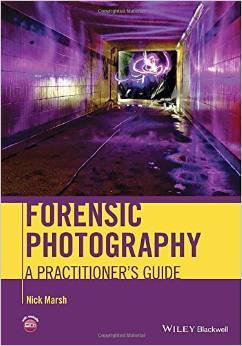The Artistry & Technique of A London Forensic Photographer
 As photographers we often find ourselves waist deep in odd-jobs searching for that next big opportunity. From the inaugural $150 wedding job to the corporate client that pays more for three days of work than you've ever made in a month; opportunities can take you anywhere and everywhere in-between.
As photographers we often find ourselves waist deep in odd-jobs searching for that next big opportunity. From the inaugural $150 wedding job to the corporate client that pays more for three days of work than you've ever made in a month; opportunities can take you anywhere and everywhere in-between.
How about the opportunity to investigate a murder? Heck, maybe even solve one? Well this is the day to day reality of London Metropolitan Police Department Forensic Photographer Nick Marsh. With 30 years on the force, and 20 of them as a forensic photographer, Nick's uses his analytical approach to photography fusing art and technique to unearth some of London's most gruesome mysteries.
The Forensic Photographer
[embed]https://youtu.be/U6o2AQ-dndY[/embed]
The Photographic Eye
Imagine this: There's a young woman sitting in a café near the window...
The portrait photographer notices how the contours of her face are gently lit by the setting sun, while the photojournalist sees the empty seat in front of her and the constant glances outside. The forensic photographer sees a perfect lipstick mark left on the coffee cup, while the fashion photographer prefers a lighter shade.
First popularized by Malcolm Gladwell's book "Outliers: The Story of Success", it's commonly said that to become an expert at something, it takes 10,000 hours of practice at the given skill. That's roughly 20 hours a week for 10 years.
While that may be true, it surely doesn't take that long to develop a habit. Meaning it doesn't necessarily take 10 years behind the camera to start to think like a photographer. As photographers we train ourselves consciously and subconsciously through experience and muscle memory. With all the places photography can take you, it's interesting how each of us interpret our surroundings differently, what I call - how we perceive the woman by the window.
This short documentary by director David Beazley provides an intriguing look at one photographers such interpretations of the world around him.
It's All About the Light
One recurring piece of insight you'll find time and time again from professional photographers is that it's not about the camera it's about the photographer. On the importance of photographic equipment, Nick Marsh would tell you:
"As a matter of fact the camera in most types of photography we undertake is irrelevant, it's about light. It's about understanding about the way light is going and what we need to see in our image."
..And the Knowledge
Sure you need equipment capable enough for the type of work you are doing, but beyond that it's not about how many bells and whistles you've got or how big you camera case is. Nick stresses the importance training in photography. For him the artistic eye is used to unearth the fact of the matter, while being sure not to misrepresent the reality of the scene.
"If you've got limited training, say for example a fatal accident, and you're trying to recreate that for the jury as-is with true perspective, one of the most common things I see is the use things like a wide-angled lens. Which clearly distorts perspective and appears to make the the vehicles look twice the distance they are away. So if you put that into court you're actually giving them false information.. The Level of knowledge is reduced."
The Proactive Use of Light in Forensic Photography
In the video Nick mentions an investigation of a murder where crucial evidence was discovered on the wall of a flat by use of infrared imaging. In his book Forensic Photography: A Practitioner's Guide he details the crime further.
... In this case a suspect was arrested for multiple murders around the St Pancras area of London. On his arrest his flat was searched and half a torso was found in his bedroom. When the rest of flat was treated with luminol in the search for blood, it was clear that thcrc had been a lot of previous activity. When a light source search was carried out for latent linger marks to ascertain who else might have been there, in terms of victims or other suspects, a small area of erased writing was found, as in the above case. In this case, however, it was almost illegible even under the laser. As is standard practice we then repeated the search area using a tunable light source through the spectrum, starting at UV finishing at IR. To mist with the viewing of IR, a video camera with an IR viewing mode was used and this time the area showed a girl's name. The walls of the flat were then speculatively searched and vidcoed (as required) using IR and another four or five names were found. These names subsequently turned out to be the names of previous victims.
If you're curious what it takes be a London MET Forensic Photographer, well first you've got to already be employed as Police Photographic Officer. Second, you can take this course:
Professional Forensic Photography Attendance Criteria
This course is for police staff currently employed as Photographic Officers.
Course aim
To enable the student to develop advanced stills techniques to use at Scenes of Crime.
Course objectives
The student will be able to:
Demonstrate using the equipment Describe relevant procedures and policy that impact on crime scene photography Demonstrate the ability to adapt techniques to different scenes Describe legal issues that impact on crime scene photography Demonstrate completing relevant paperwork Conduct critical assessment of their work
Duration; 15 days Course number; CS209


